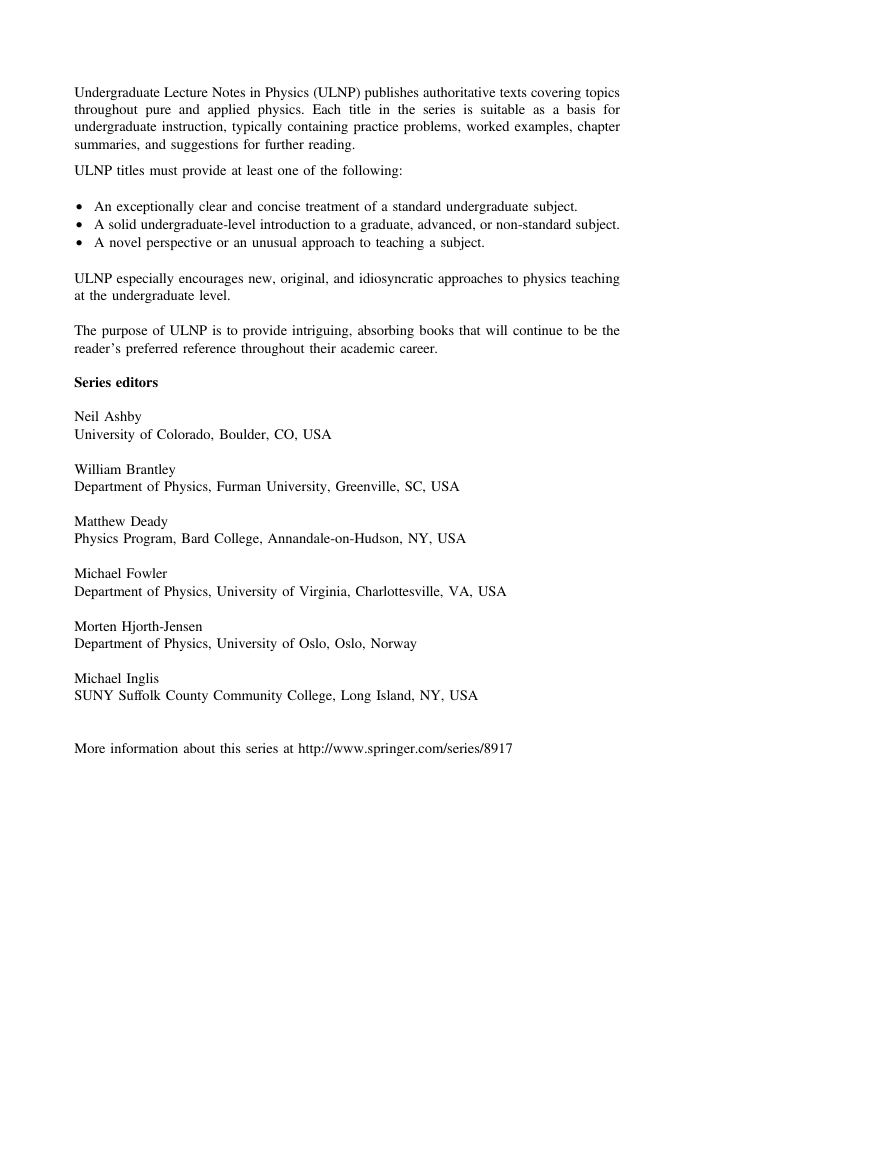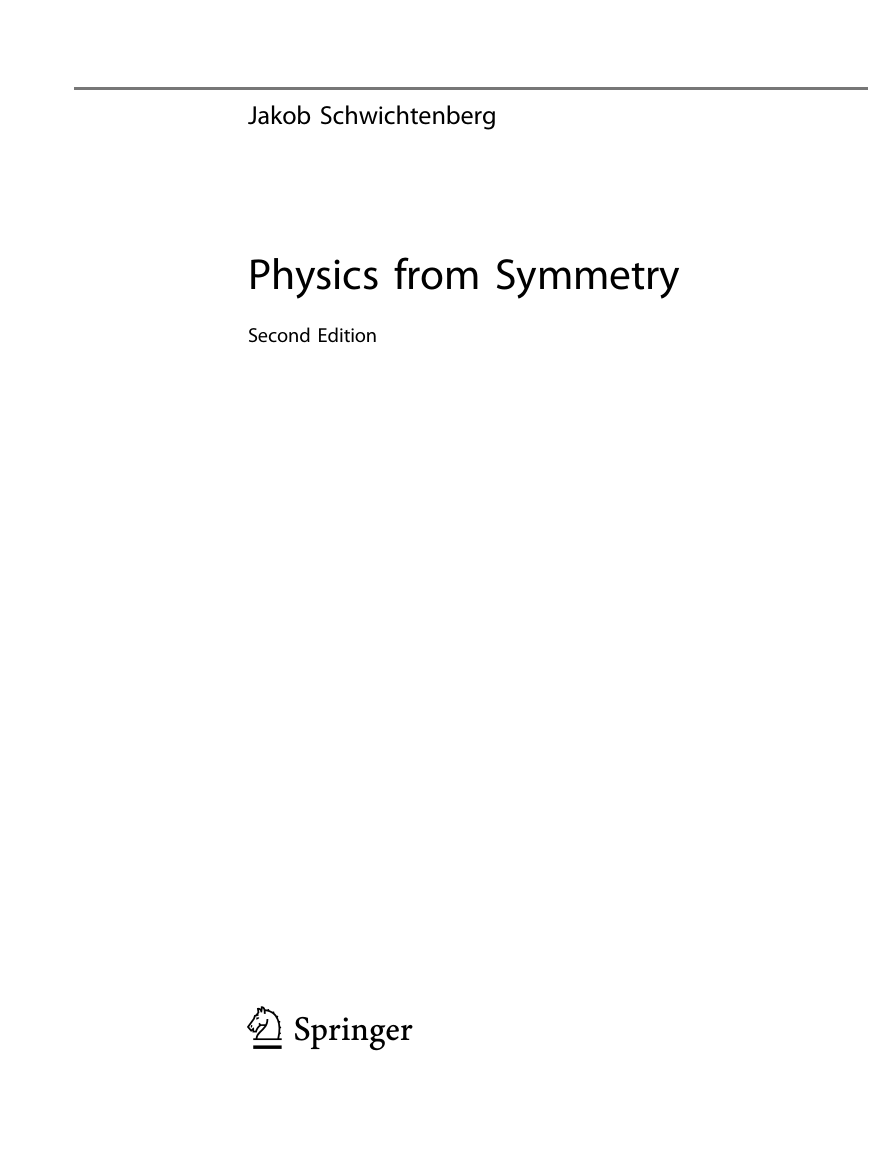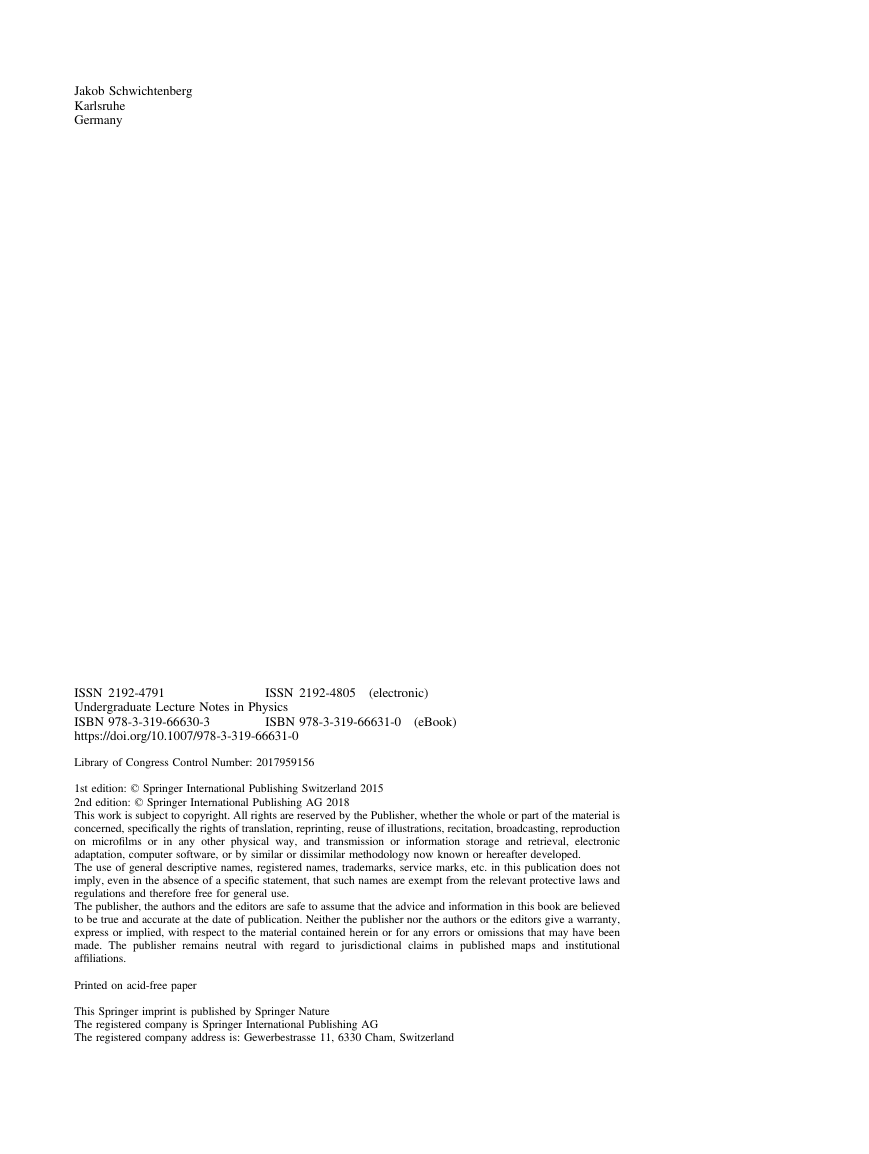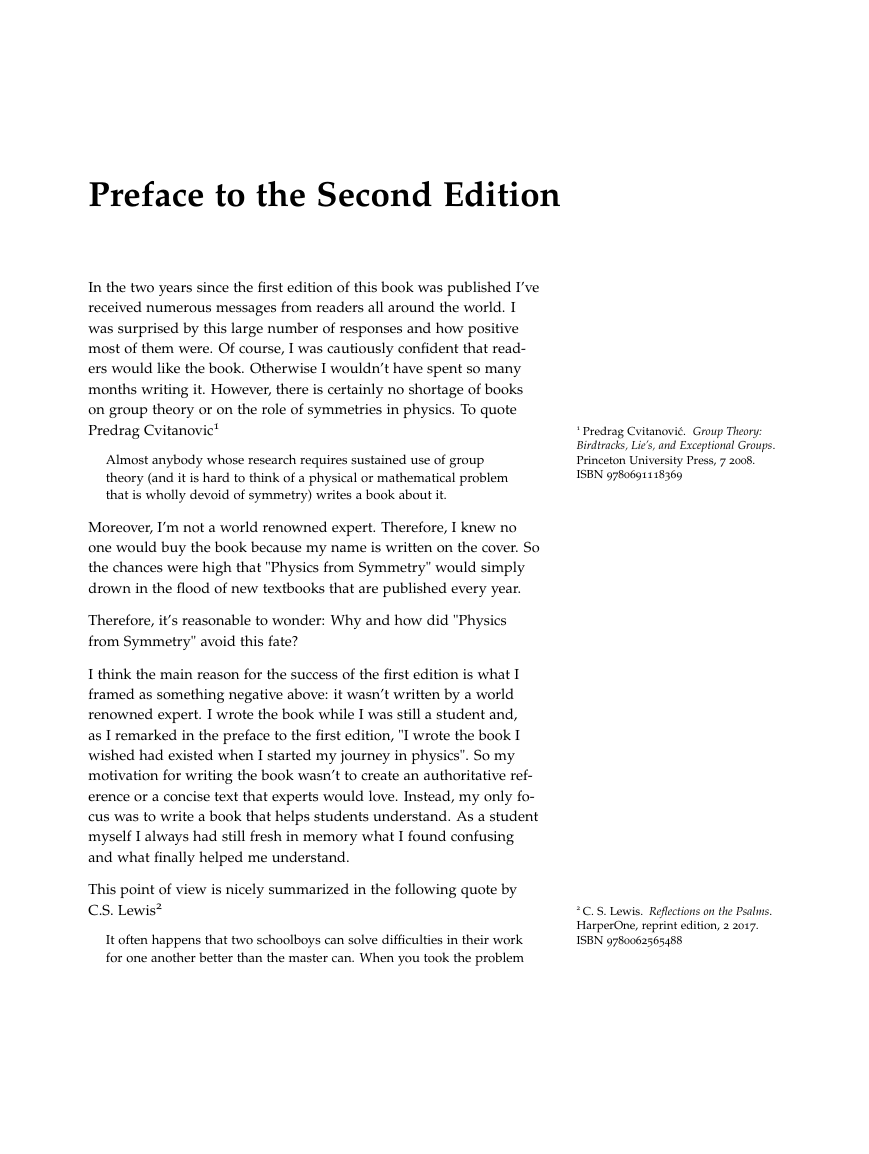Preface to the Second Edition
Preface to the First Edition
Acknowledgments
Contents
Part I Foundations
1 Introduction
1.1 What we Cannot Derive
1.2 Book Overview
1.3 Elementary Particles and Fundamental Forces
2 Special Relativity
2.1 The Invariant of Special Relativity
2.2 Proper Time
2.3 Upper Speed Limit
2.4 The Minkowski Notation
2.5 Lorentz Transformations
2.6 Invariance, Symmetry and Covariance
Part II Symmetry Tools
3 Lie Group Theory
3.1 Groups
3.2 Rotations in two Dimensions
3.2.1 Rotations with Unit Complex Numbers
3.3 Rotations in three Dimensions
3.3.1 Quaternions
3.4 Lie Algebras
3.4.1 The Generators and Lie Algebra of SO(3)
3.4.2 The Abstract Definition of a Lie Algebra
3.4.3 The Generators and Lie Algebra of SU(2)
3.4.4 The Abstract Definition of a Lie Group
3.5 Representation Theory
3.6 SU(2)
3.6.1 The Finite-dimensional Irreducible Representations of SU(2)
3.6.2 The Representation of SU(2) in one Dimension
3.6.3 The Representation of SU(2) in two Dimensions
3.6.4 The Representation of SU(2) in three Dimensions
3.7 The Lorentz Group O(1, 3)
3.7.1 One Representation of the Lorentz Group
3.7.2 Generators of the Other Components of the Lorentz Group
3.7.3 The Lie Algebra of the Proper Orthochronous Lorentz Group
3.7.5 The (1/2, 0) Representation
3.7.6 The (0, 1/2 ) Representation
3.7.7 Van der Waerden Notation
3.7.8 The (1/2, 1/2) Representation
3.7.9 Spinors and Parity
3.7.10 Spinors and Charge Conjugation
3.7.11 Infinite-Dimensional Representations
3.8 The Poincaré Group
3.9 Elementary Particles
3.10 Appendix: Rotations in a Complex Vector Space
3.11 Appendix: Manifolds
4 The Framework
4.1 Lagrangian Formalism
4.1.1 Fermat’s Principle
4.1.2 Variational Calculus - the Basic Idea
4.2 Restrictions
4.3 Particle Theories vs. Field Theories
4.4 Euler-Lagrange Equation
4.5 Noether’s Theorem
4.5.1 Noether’s Theorem for Particle Theories
4.5.2 Noether’s Theorem for Field Theories - Spacetime Symmetries
4.5.3 Rotations and Boosts
4.5.4 Spin
4.5.5 Noether’s Theorem for Field Theories - Internal Symmetries
4.6 Appendix: Conserved Quantity from Boost Invariance for Particle Theories
4.7 Appendix: Conserved Quantity from Boost Invariance for Field Theories
Part III The Equations of Nature
5 Measuring Nature
5.1 The Operators of Quantum Mechanics
5.1.1 Spin and Angular Momentum
5.2 The Operators of Quantum Field Theory
6 Free Theory
6.1 Lorentz Covariance and Invariance
6.2 Klein-Gordon Equation
6.2.1 Complex Klein-Gordon Field
6.3 Dirac Equation
6.4 Proca Equation
7 Interaction Theory
7.1 U(1) Interactions
7.1.1 Internal Symmetry of Free Spin 1/2 Fields
7.1.2 Internal Symmetry of Free Spin 1 Fields
7.1.3 Putting the Puzzle Pieces Together
7.1.4 Inhomogeneous Maxwell Equations and Minimal Coupling
7.1.5 Charge Conjugation, Again
7.1.6 Noether’s Theorem for Internal U(1) Symmetry
7.1.7 Interaction of Massive Spin 0 Fields
7.1.8 Interaction of Massive Spin 1 Fields
7.2 SU(2) Interactions
7.3 Mass Terms and "Unification" of SU(2) and U(1)
7.4 Parity Violation
7.5 Lepton Mass Terms
7.6 Quark Mass Terms
7.7 Isospin
7.7.1 Labelling States
7.8 SU(3) Interactions
7.8.1 Color
7.8.2 Quark Description
7.9 The Interplay Between Fermions and Bosons
Part IV Applications
8 Quantum Mechanics
8.1 Particle Theory Identifications
8.2 Relativistic Energy-Momentum Relation
8.3 The Quantum Formalism
8.3.1 Expectation Value
8.4 The Schrödinger Equation
8.4.1 Schrödinger Equation with an External Field
8.5 From Wave Equations to Particle Motion
8.5.1 Example: Free Particle
8.5.2 Example: Particle in a Box
8.5.3 Dirac Notation
8.5.4 Example: Particle in a Box, Again
8.5.5 Spin
8.6 Heisenberg’s Uncertainty Principle
8.7 Comments on Interpretations
8.8 Appendix: Interpretation of the Dirac Spinor Components
8.9 Appendix: Solving the Dirac Equation
8.10 Appendix: Dirac Spinors in Different Bases
8.10.1 Solutions of the Dirac Equation in the Mass Basis
9 Quantum Field Theory
9.1 Field Theory Identifications
9.2 Free Spin 0 Field Theory
9.3 Free Spin Field Theory
9.4 Free Spin 1 Field Theory
9.5 Interacting Field Theory
9.5.1 Scatter Amplitudes
9.5.2 Time Evolution of States
9.5.3 Dyson Series
9.5.4 Evaluating the Series
9.6 Appendix: Most General Solution of the Klein-Gordon Equation
10 Classical Mechanics
10.1 Relativistic Mechanics
10.2 The Lagrangian of Non-Relativistic Mechanics
11 Electrodynamics
11.1 The Homogeneous Maxwell Equations
11.2 The Lorentz Force
11.3 Coulomb Potential
12 Gravity
13 Closing Words
Part V Appendices
A Vector calculus
A.1 Basis Vectors
A.2 Change of Coordinate Systems
A.3 Matrix Multiplication
A.4 Scalars
A.5 Right-handed and Left-handed Coordinate Systems
B Calculus
B.1 Product Rule
B.2 Integration by Parts
B.3 The Taylor Series
B.4 Series
B.4.1 Important Series
B.4.2 Splitting Sums
B.4.3 Einstein’s Sum Convention
B.5 Index Notation
B.5.1 Dummy Indices
B.5.2 Objects with more than One Index
B.5.3 Symmetric and Antisymmetric Indices
B.5.4 Antisymmetric
B.5.5 Two Important Symbols
C Linear Algebra
C.1 Basic Transformations
C.2 Matrix Exponential Function
C.3 Determinants
C.4 Eigenvalues and Eigenvectors
C.5 Diagonalization
D Additional Mathematical Notions
D.1 Fourier Transform
D.2 Delta Distribution
Bibliography
Index
















 2023年江西萍乡中考道德与法治真题及答案.doc
2023年江西萍乡中考道德与法治真题及答案.doc 2012年重庆南川中考生物真题及答案.doc
2012年重庆南川中考生物真题及答案.doc 2013年江西师范大学地理学综合及文艺理论基础考研真题.doc
2013年江西师范大学地理学综合及文艺理论基础考研真题.doc 2020年四川甘孜小升初语文真题及答案I卷.doc
2020年四川甘孜小升初语文真题及答案I卷.doc 2020年注册岩土工程师专业基础考试真题及答案.doc
2020年注册岩土工程师专业基础考试真题及答案.doc 2023-2024学年福建省厦门市九年级上学期数学月考试题及答案.doc
2023-2024学年福建省厦门市九年级上学期数学月考试题及答案.doc 2021-2022学年辽宁省沈阳市大东区九年级上学期语文期末试题及答案.doc
2021-2022学年辽宁省沈阳市大东区九年级上学期语文期末试题及答案.doc 2022-2023学年北京东城区初三第一学期物理期末试卷及答案.doc
2022-2023学年北京东城区初三第一学期物理期末试卷及答案.doc 2018上半年江西教师资格初中地理学科知识与教学能力真题及答案.doc
2018上半年江西教师资格初中地理学科知识与教学能力真题及答案.doc 2012年河北国家公务员申论考试真题及答案-省级.doc
2012年河北国家公务员申论考试真题及答案-省级.doc 2020-2021学年江苏省扬州市江都区邵樊片九年级上学期数学第一次质量检测试题及答案.doc
2020-2021学年江苏省扬州市江都区邵樊片九年级上学期数学第一次质量检测试题及答案.doc 2022下半年黑龙江教师资格证中学综合素质真题及答案.doc
2022下半年黑龙江教师资格证中学综合素质真题及答案.doc